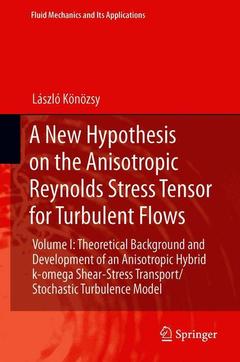Description
A New Hypothesis on the Anisotropic Reynolds Stress Tensor for Turbulent Flows, 1st ed. 2019
Volume I: Theoretical Background and Development of an Anisotropic Hybrid k-omega Shear-Stress Transport/Stochastic Turbulence Model
Fluid Mechanics and Its Applications Series, Vol. 120
Author: Könözsy László
Language: English
Subjects for A New Hypothesis on the Anisotropic Reynolds Stress...:
Keywords
Anisotropic Reynolds stress tensor; Beyond the Boussinesq hypothesis; Reynolds momentum equation; Turbulent kinetic energy equation; Galilean invariance of the Reynolds stress tensor; Hybrid k-omega SST turbulence models; Similarity theory of turbulent velocity fluctuations; Mechanical similitudes of oscillatory motions; Boundary layer and shear flows; Advanced stochastic turbulence models; fluid- and aerodynamics
141 p. · 15.5x23.5 cm · Hardback
Description
/li>Contents
/li>Comment
/li>
This book gives a mathematical insight--including intermediate derivation steps--into engineering physics and turbulence modeling related to an anisotropic modification to the Boussinesq hypothesis (deformation theory) coupled with the similarity theory of velocity fluctuations.
Through mathematical derivations and their explanations, the reader will be able to understand new theoretical concepts quickly, including how to put a new hypothesis on the anisotropic Reynolds stress tensor into engineering practice. The anisotropic modification to the eddy viscosity hypothesis is in the center of research interest, however, the unification of the deformation theory and the anisotropic similarity theory of turbulent velocity fluctuations is still missing from the literature. This book brings a mathematically challenging subject closer to graduate students and researchers who are developing the next generation of anisotropic turbulence models.Indispensable for graduate students, researchers and scientists in fluid mechanics and mechanical engineering.
Helps the reader understand a new concept in the fields of engineering physics and advance turbulence modeling
Presents all intermediate mathematical derivation steps in one place
Discusses a recently developed three-dimensional anisotropic similarity theory of turbulent velocity fluctuations in-depth
Proposes a new hypothesis that could open a new research area in the description of anisotropic turbulence




